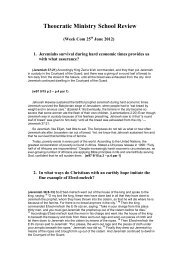1964 Awake! - Theocratic Collector.com
1964 Awake! - Theocratic Collector.com
1964 Awake! - Theocratic Collector.com
You also want an ePaper? Increase the reach of your titles
YUMPU automatically turns print PDFs into web optimized ePapers that Google loves.
Other Navigators<br />
Like birds, green turtles can also find a<br />
speck of land in the middle of an ocean.<br />
Turtles from Brazil swim about 1,400 miles<br />
to Ascension Island, a tiny piece of land<br />
only seven miles wide in the Atlantic<br />
Ocean between South America and Africa.<br />
For these turtles to navigate accurately<br />
to that tiny island is a remarkable feat.<br />
It is believed that they use the same method<br />
of navigation as used by migratory<br />
birds. But their location-finding ability is<br />
possessed by many other inhabitants of the<br />
oceans.<br />
Eels migrate through the Atlantic Ocean<br />
from rivers in Europe and America to<br />
their spawning grounds near the Bahama<br />
Islands. For many of them this is a trip<br />
of thousands of miles. Every year Alaskan<br />
fUr seals swim 3,000 miles to the Pribilof<br />
Islands to give birth to their young, and<br />
they too find their destination without difficulty.<br />
Salmon swim hundreds of miles<br />
through the Pacific Ocean at spawning<br />
time to ascend rivers that they left years<br />
before as mere fingerlings. With astounding<br />
homing ability they return to the very<br />
streams where they were hatched. Even<br />
insects have an amazing sense of direction.<br />
Monarch butterflies migrate more than<br />
1,800 miles from eastern Canada to San<br />
Luis Potosi in Mexico without getting lost.<br />
Bees know the direction in which they<br />
found food and are able to <strong>com</strong>municate<br />
that direction to other bees by a peculiar<br />
dance in the hive. Foraging ants do not<br />
lose their way when they are hundreds of<br />
feet from their nests but are able to find<br />
their way back. Solitary wasps have no<br />
trouble locating their individual nests in<br />
the ground although they may have to fly<br />
hundreds of yards away to locate a spider<br />
or caterpillar to stuff into it. Whether they<br />
appro§lch it from the air or from the<br />
ground, they are able to find it despite its<br />
tiny size and inconspicuous appearance.<br />
10<br />
These and many other creatures seem to<br />
have a surpriSingly good sense of direction.<br />
What many of them succeed in doing instinctively<br />
man can do only with special<br />
instruments. Not until recent years did<br />
man begin to realize how some birds, animals,<br />
insects and sea creatures are able to<br />
travel without getting lost.<br />
Celestial Navigation<br />
Experiments by researchers have revealed<br />
the remarkable fact that the sun,<br />
moon and stars are important factors in<br />
the direction-finding ability of certain<br />
creatures. Early in the 1950's investigators<br />
such as G. V. T. Matthews of England and<br />
Gustav Kl'amer of Germany tlU'ned up con<br />
Vincing evidence that pigeons and wild<br />
birds orient themselves by means of the<br />
sun, using it as a <strong>com</strong>pass.<br />
While working with starlings, Kramer<br />
discovered that their direction of flight in<br />
a building could be altered by deflecting<br />
sunlight through different windows by<br />
means of mirrors. He also found that they<br />
used the sun to locate a feeding station<br />
they had been trained to look for in a particular<br />
direction. With their surroundings<br />
screened off from them, all they could see<br />
was the sky. On sunny days they found<br />
the feeding station with no difficulty, but<br />
on overcast days they hunted for it at<br />
random.<br />
An experiment performed with warblers<br />
by another researcher, E. G. F. Sauer of<br />
Switzerland, proved that they can orient<br />
themselves not only by the SlU1 but also<br />
by the stars. When migration time came,<br />
caged warblers would invariably take up<br />
the right direction of flight. The only clue<br />
they had as to direction was the night sky<br />
They watched it so closely that meteors<br />
would cause a momentary change in their<br />
direction of flight. Whenever the sky was<br />
hidden by clOUds they became disoriented.<br />
AWAKE}




